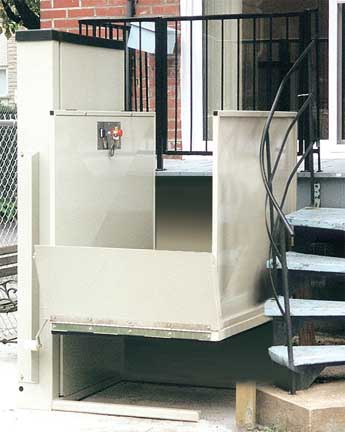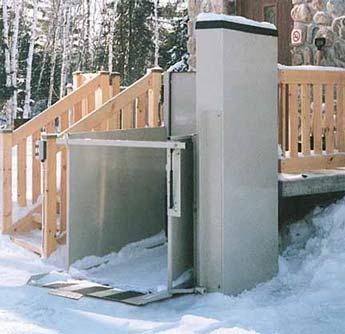Porch Lift Fact Sheet

Porch lifts are a type of vertical platform lift and are fairly large machines which are normally, but not always, installed outside to provide access to a porch or deck for a wheelchair user. The wheelchair user simply rolls onto the lift platform, pushes the lift button to rise to the deck or porch level and then rolls off the lift. Depending on the height the lift platform needs to travel, the whole process shouldn't take more than 30 to 60 seconds.
Although all vertical platform lifts can be configured to be accessed from either the ends or the side, entering and exiting through the ends of the platform is by far the easiest for the user. When using the ends to access the lift the user rolls straight onto the lift and straight off but when using the side of the platform to access the lift, the wheelchair user has to perform a manoeuvre similar to parallel parking a car many users find accessing a vertical platform lift of any kind virtually impossible even with the help of a caregiver.
There is a short metal ramp at the lower entry end of the porch lift platform to enable easier access to the lift which folds up when the lift is raised to provide a safety barrier that prevents the user from rolling off the platform while using it. There will be a tower on one side of the porch lift which houses the electronics and supports the lift platform.
Although most porch lifts allow for about 4' of travel, some only allow 3' and some can travel as much as 12'. Generally you'll want to buy the shortest unit possible which will still give you the amount of travel you need.
I did one installation where the amount of travel need was 50"; as the standard porch lift at the time had 4' of travel we were forced to consider the 6' porch lift at an extra cost of about $1,500.00. After giving it a bit of thought I asked the contractor putting in the cement pad to make it 2" thicker. The thicker pad, which cost only an extra $100.00 or so, allowed us to get away with using the standard 4' model.
On the lift platform there is a small control panel which usually houses a emergency stop switch, an up and down switch and a key switch which turns the power on. Because the unit will not work without the key being turned on, the owner of the lift does not have to worry about kids, or others, playing with the lift or using it without permission.
Under the platform of the lift there is a safety pan, usually made out of metal, which when touched will stop the lift from moving down. This is to prevent from crushing, kids, pets or articles which may inadvertently end up under the lift.
Because these lifts are built to be used outside regardless of the weather they work well in the northern climates however there is a small issue with snow build-up under the lift. If the lift is left in the up position during a snow storm and snow drifts in under the porch lift, the lift's safety pan will prevent it from traveling all the way down. The easiest way to prevent this is to leave the lift platform on the ground when not in use. This way no snow will be able to build up underneath.
Another safety issue with porch lifts is the fact that when the lift platform is in the lowered position, there is an unprotected drop off on the porch or deck down to the bottom of lift. For this reason, it is normally required that a self closing gate be installed on the porch or deck. This can some times be as simple as cutting out the existing railing, which will have to be cut out anyway, and installing hinges with springs in them to the section of railing removed creating a gate.
An option for most vertical platform lifts are call/send switches. There can be one or two of them and they can be installed at the bottom, or top, or both the bottom and the top of the lift's travel. Having a switch at the top of the lift is handy to be able to send the lift down when not in use to prevent snow and debris build-up under the platform. Having a switch at both ends is useful when there is more than one person using the lift as there will be times when the lift will be in the wrong position for access for someone.
Some lift companies offer fairly expensive enclosures to keep the lift and the user out of the weather while in use. Most customers find it much less expensive to either just build a roof over the lift or a full enclosure themselves. Bear in mind that building codes may have to be met in your area when building these structures around the lift.

Speaking of building codes, I've seen some manufacturers say their lifts can be sat on patio slabs but in my area, and many others, a concrete pad must be built. I always recommend that these concrete pads be large enough to not only support the lift but to also provide an area at the entrance of the lift that the wheelchair will fit on. The pads should also be built so there won't be any water build up under or around the lift due to rain or snow melting. I've seen cases where snow has melted around a lift and has run under the lift only to freeze overnight and freezing the lift platform to the ground or encasing the mechanical parts inside the tower in a block of ice.
Everything I've talked about refer to residential applications of porch lift but in some cases these lifts can be used in commercial buildings. When used in a commercial building, in my area, building and fire inspectors must approve the lift's installation and fairly strict building codes must be adhered to. These lifts must also be licensed and inspected regularly by the Ontario government when used in commercial buildings here. Never buy one of these lifts for commercial use without checking in your area for codes and restrictions.
The last thing I'd like to address when buying a porch lift is that, while they all look similar and work in a similar way, there may be differences in their size and capacity. If you're a 250 lb. user sitting in a 300 lb. wheelchair, don't buy a lift rated for 500 lbs. If you're currently in a manual wheelchair but expect your condition might change requiring you to use a power chair in the future, buy a lift with a higher weight capacity.


 Online Vendors
Online Vendors  US Online Vendors
US Online Vendors 